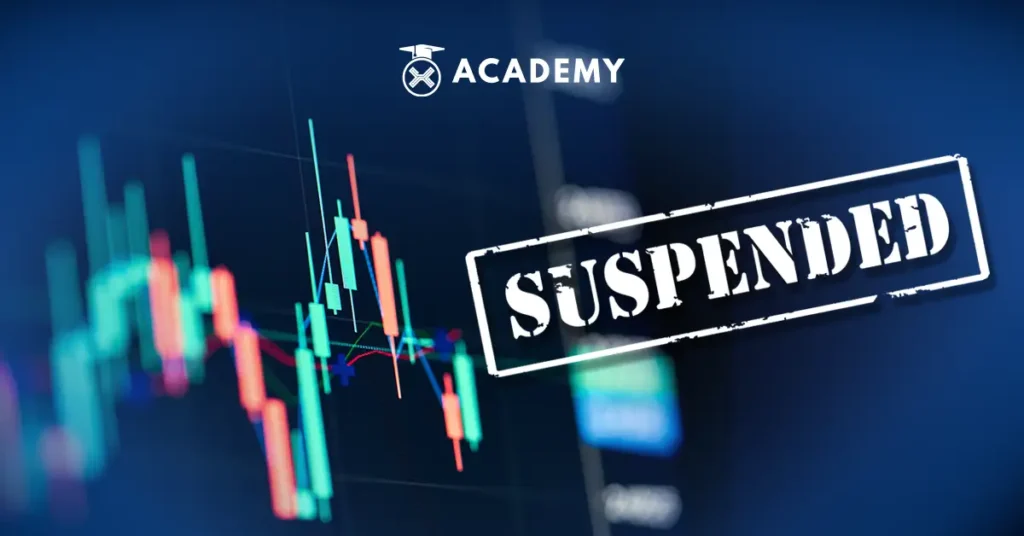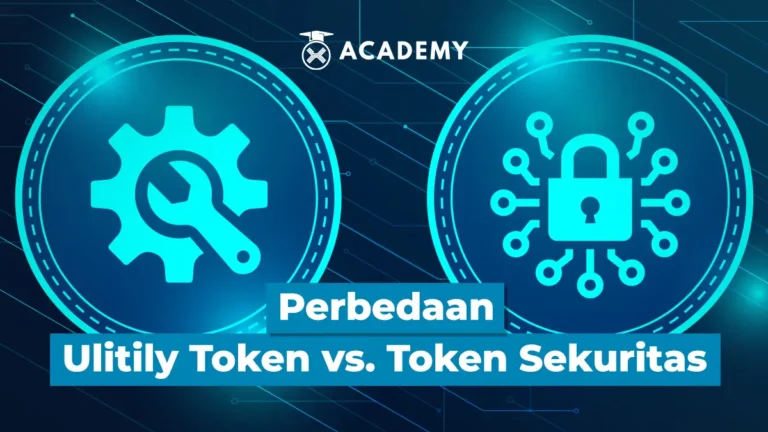One term that is often found in the investment world is suspend. In general, suspend is a term that means “to delay” or “to suspend.”
In an investment context, suspend refers to temporarily suspending stock trading on a stock exchange.
Suspends can occur on various assets, including stocks on conventional stock exchanges and cryptos on crypto markets. In crypto, a trading suspension can occur on a crypto platform or exchange.
To better understand what a suspension is, the factors that cause it, the timeframe, the sanctions if you get suspended, and examples, check out the following reviews!
What is a Stock Suspension?
Quoting ocbc.id, a stock suspension is a temporary measure to hold stock trading on the stock exchange by the Indonesia Stock Exchange (IDX) against listed companies, namely issuers or public companies.
This policy is implemented as an intervention effort from the IDX to maintain smoothness, fairness, and efficiency in securities transactions.
By implementing a suspension, the IDX intends to maintain market order and ensure that securities trading occurs in an orderly, fair, and efficient manner.
Causal Factors of Stock Suspension

Quoting ocbc.id, the following are some of the factors that can lead to a stock suspension, including:
1. Big News from the Issuing Company
When there is important news from the issuing company, the company usually notifies the stock exchange of the development. In response, the stock exchange may immediately suspend trading.
This gives the market time to absorb the important information announced without being affected by excessive price fluctuations.
Examples of big news may include major corporate innovations, mergers or acquisitions, or changes in corporate ownership.
2. Company Unable to Meet Data Completeness
Sometimes, the stock exchange may ask the issuing company to complete certain data within a certain period of time. If the company does not fulfill the request, it may lead to suspension of trading.
Usually, this action is taken by the stock exchange after no response from the issuer for one to two years. To overcome a trading suspension, the company must provide the information requested by the stock exchange.
The suspension can be lifted once the information is provided, and trading can resume as usual.
3. Unlawful Activities of the Issuer
Trading suspensions on issuers indicate that they are unable to conduct stock transactions. One
One of the reasons is that the issuer or the company issuing the shares is suspected or even proven to be involved in violating the law. Therefore, the stock exchange takes a suspension step to protect the interests of investors.
4. Possibility of Market Manipulation
Market manipulation is not only limited to the issuing company but can also come from other market participants, such as the stock exchange or investors.
If there is a suspicion of market manipulation, the stock exchange or investors may take steps to suspend trading to allow time for investigation.
Although fraud, whether from inside or outside the company, tends to be rare, if it does occur, the suspension of trading may last for an extended period.
The impact is also likely to be long-term, taking time to recover and rebuild investor confidence in the stock market.
How Long Does Stock Suspension Occur?
Quoting ocbc.id, the duration of a stock suspension varies depending on the violation type so it can be short or longer. The severity of the offense committed influences the duration of the suspension.
For minor violations, the suspension may last only days or weeks. An example is several cases of suspended trading due to technical errors.
After confirmation with the issuing company and resolution of the issue, trading can resume immediately, even in less than a day.
However, if the violation is serious, the suspension may last for months or even years. At the national stock trading level, trading can resume without delay once the suspended trading status is lifted.
What Are the Sanctions If Affected by Stock Suspension?
The IDX gives five types of sanctions to companies or issuers that have been sanctioned with a stock suspension. The sanctions are adjusted to the severity of the violations committed by the company. The types of sanctions applied by the IDX to companies are as follows:
1. Maximum Fine of IDR 500,000,000
The first sanction given by the IDX to companies involved in violations or other factors is a maximum fine of IDR 500,000,000.
2. Written Reprimand
The second step is to give a written warning to the company by the IDX if there are violations or other conditions that cause the company to be sanctioned with a stock suspension.
3. Written Warning
After the company receives a written warning, the next step is receiving a warning from the IDX. The IDX will not immediately impose sanctions on the company but will first conduct an evaluation and provide an opportunity for the company to provide a defense before sanctions are imposed.
4. Temporary Ban on Trading on the Stock Exchange
If the company commits a violation or is involved in the previously mentioned factors, the sanctions involve temporary restrictions on trading activities on the stock exchange.
5. Removal of Membership
The IDX will revoke the company’s membership status in the last stage. This means the company no longer has the right to trade on the exchange. As is known, membership and fulfillment of all applicable requirements are absolute requirements for companies that want to trade on the stock exchange.
Knowing Suspend in Crypto & What Causes It

Quoting investopedia.com, the United States Securities and Exchange Commission (SEC) has the authority to suspend trading in a security for a maximum of ten (10) trading days to protect investors under Section 12(k) of the Securities Exchange Act of 1934.
The SEC will make this decision based on the results of its investigation and will then issue a press release explaining the reasons behind the suspension.
During the ten-day period, the SEC will not publicly comment on the status of the investigation.
Once trading of a security is suspended, the stock cannot be traded until the suspension is lifted or expires. The suspension time is determined on a case-by-case basis. Suspended trading occurs for a variety of reasons, including:
Unavailability of current, accurate, or sufficient information about a company, such as when a company does not file current periodic reports.
Doubts regarding the accuracy of publicly available information, including the content of recent press releases.
Concerns related to stock trading, such as insider trading or market manipulation.
The most common reason for suspension is the lack of current or accurate financial information. Companies can often resolve this issue by filing the necessary financial statements to return to regulatory compliance.
Rarer cases involve acts of fraud, where a company may suffer long-term repercussions from a trading suspension.
Examples of Suspend
Quoting investopedia.com, there have been several instances of suspended trading in recent history. One of the most famous cases is the Enron scandal that unfolded in 2001.
The company’s share price plummeted, and in just a few days, the price dropped to a few pennies. Enron later filed for bankruptcy that same year, and the New York Stock Exchange (NYSE) suspended trading in Enron’s shares the following year, arguing that a share price below $1 violated Big Board standards. Most recently, the NYSE suspended trading in several Nasdaq-listed stocks, such as Alphabet (GOOG) and Amazon (AMZN), for less than a day.
A technical glitch caused traders to receive trade execution reports unusually.
What is the Solution For Being Suspended?
Quoting ocbc.id, several solution options can be taken for companies that the IDX has suspended.
The following are two solution options that companies can implement to lift the suspension status and allow stock trading to resume:
1. Waiting for the Revocation of Suspended Stock Status
One of the solutions available to companies that have been suspended is to wait until the IDX lifts the suspension status. By patiently waiting for the suspension to be lifted, there is the potential for an increase in the share price.
However, remember that the time required for the suspension to be lifted can vary, ranging from a few days to months to years.
In addition, it is possible that the suspension may not be lifted at all or may be followed by the removal of membership.
Companies must pay attention to the time required to avoid the risk of forced delisting, which can cause huge losses.
2. Selling Suspended Shares
The second solution companies can implement is to sell shares under suspension status. This action can be implemented by selling the shares through the negotiation market. This strategy can reduce the impact of losses, especially if investors are interested in buying the shares.
However, remember that the disadvantage of selling suspended shares is investors’ potential lack of interest due to the suspended status given to the shares.
As is well known, companies that have been suspended are at risk of incurring huge losses in the future and may even no longer be able to trade on the stock exchange.
If there are investors who are interested in buying the shares, there is a possibility that the price offered will be much lower than the market price before the suspension.
Therefore, a wise policy is required in determining the steps or solutions to be taken in such a situation.
Invest in Crypto Assets on INDODAX with Staking (EARN) Feature
Well, now you understand what a suspension is, the factors that cause it, the time period, the sanctions if you are suspended, to the example and don’t forget to read the latest articles from INDODAX Academy.
Furthermore, if you want to invest in crypto assets, you are advised to choose a safe and reliable Indonesian crypto exchange, INDODAX.
Currently, INDODAX has a crypto staking or crypto earn feature that allows you to secure your crypto assets similarly to keeping funds in a savings account.
The crypto assets you lock up through the INDODAX Earn feature will later provide rewards, such as interest earned from savings.
The INDODAX Earn crypto staking feature can be accessed easily, anytime and anywhere, either through the Mobile App or desktop on the INDODAX website, namely on the INDODAX Earn crypto staking page.
Start investing in crypto assets right now with the crypto staking feature with INDODAX!








